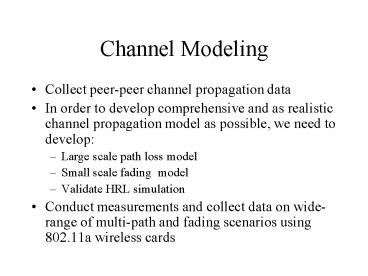Channel Modeling - PowerPoint PPT Presentation
Title:
Channel Modeling
Description:
Channel Modeling Collect peer-peer channel propagation data In order to develop comprehensive and as realistic channel propagation model as possible, we need to develop: – PowerPoint PPT presentation
Number of Views:90
Avg rating:3.0/5.0
Title: Channel Modeling
1
Channel Modeling
- Collect peer-peer channel propagation data
- In order to develop comprehensive and as
realistic channel propagation model as possible,
we need to develop - Large scale path loss model
- Small scale fading model
- Validate HRL simulation
- Conduct measurements and collect data on
wide-range of multi-path and fading scenarios
using 802.11a wireless cards
2
- Test Scenario 1 Indoor laboratory setup
- Setup two test computers in the laboratory
- Conduct measurements under controlled lab
environment - Measure set of parameters such as RSSI, PER, SNR,
etc. - Conduct similar experiments in outdoor setup as
described in following slides
3
- Test Scenario 2 Highway setup
- Setup two test vehicles (stationary) on highway
shoulders - Conduct setup of measurement under following
conditions - Minimum/light traffic (late night)
- Medium traffic (early morning / afternoon)
- Heavy traffic (peak hours)
- Repeat measurements in different hwy surroundings
(buildings, guard rails, uphill, etc.)
4
- Test Scenario 3 Open Intersection
- Setup two test vehicles (stationary) at an open
intersection - Conduct setup of measurement under following
conditions - Minimum/light traffic (late night)
- Medium traffic (early morning / afternoon)
- Heavy traffic (peak hours)
- Repeat measurements at different intersection
surroundings
5
- Test Scenario 4 Busy (not good line of sight)
Intersection - Setup two test vehicles (stationary) at busy
intersection - Conduct setup of measurement under following
conditions - Minimum/light traffic (late night)
- Medium traffic (early morning / afternoon)
- Heavy traffic (peak hours)
- Repeat measurements at different intersection
surroundings (semi-open)
6
- In all test scenarios, the test vehicles are
stationary - However, different traffic conditions would
provide variations in multi-path and signal
fading































